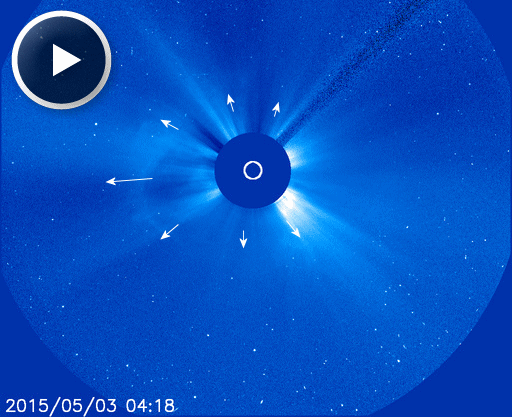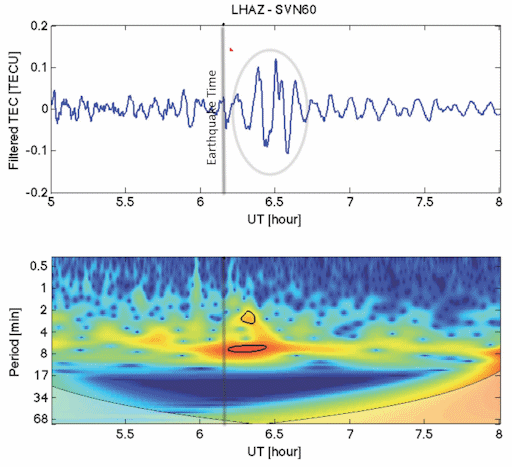Learn to photograph Northern Lights like a pro. Sign up for Peter Rosen's Aurora Photo Courses in Abisko National Park. | | | METEORS FROM HALLEY'S COMET: Earth is entering a stream of debris from Halley's Comet, source of the annual eta Aquarid meteor shower. Forecasters expect the shower to peak on May 5-6 when our planet passes through the heart of the debris zone. The best time to look is during the hours before local dawn on May 6th; sky watchers could see dozens of meteors despite glare from the waning full Moon. Live radar echoes may be heard on Space Weather Radio. EARTH-DIRECTED CME: A filament of magnetism straddling the sun's southern hemisphere erupted on May 2nd (movie) and hurled a CME into space. Modeling by NOAA analysts suggests that the CME will reach Earth on May 6th. For storm probabilities, scroll past this movie of the expanding cloud: 
Forecasters estimate a 45% chance of geomagnetic storms when the CME arrives. Bright moonlight and summer twilight will probably overwhelm any auroras around the Arctic Circle. The Antarctic Circle is much darker. Stay tuned for Southern Lights. Aurora alerts: text, voice Realtime Aurora Photo Gallery THE NEPAL EARTHQUAKE AND SPACE WEATHER: High above Earth, more than 60 km above sea level, there is a layer of our planet's atmosphere called "the ionosphere." It is where UV radiation from the sun strips electrons away from the atoms of normal air, creating a zone of charged gas that envelopes the globe. The ionosphere is very sensitive to solar storms. Turns out, it can be sensitive to earthquakes, too. NASA is reporting that the magnitude 7.8 earthquake in Nepal on April 25th created waves of energy that penetrated the ionosphere and disturbed the distribution of electrons. Note the wave pattern, circled, in the upper panel of this ionospheric electron density plot: 
Basically, these are waves of electron density rippling from a point in the ionosphere above the epicenter of the quake. The waves were measured by a science-quality GPS receiver in Lhasa, Tibet. It took about 21 minutes for the waves to travel 400 miles between the epicenter and the GPS receiving station. The bottom panel of the plot is a "dynamic spectrum." Note the hot spots outlined in black. They show that the ionosphere was ringing with periods of ~2 and ~8 minutes. Presumably, these "tones" are related to atmospheric pressure waves billowing up from the trembling Earth below. The ionosphere is the stage upon which much of space weather plays out. Auroras, meteors, and noctilucent clouds all occur there. The "Ionosphere Natural Hazards Team" at JPL studies how Earth itself affects this stage via earthquakes, volcanoes and tsunamis. You can read their report about the Nepal earthquake here. Realtime Space Weather Photo Gallery
Realtime Meteor Photo Gallery
Realtime Comet Photo Gallery
Every night, a network of NASA all-sky cameras scans the skies above the United States for meteoritic fireballs. Automated software maintained by NASA's Meteoroid Environment Office calculates their orbits, velocity, penetration depth in Earth's atmosphere and many other characteristics. Daily results are presented here on Spaceweather.com. On May. 4, 2015, the network reported 12 fireballs.
(8 sporadics, 4 eta Aquariids)  In this diagram of the inner solar system, all of the fireball orbits intersect at a single point--Earth. The orbits are color-coded by velocity, from slow (red) to fast (blue). [Larger image] [movies] Potentially Hazardous Asteroids ( PHAs) are space rocks larger than approximately 100m that can come closer to Earth than 0.05 AU. None of the known PHAs is on a collision course with our planet, although astronomers are finding new ones all the time. On May 4, 2015 there were potentially hazardous asteroids. Notes: LD means "Lunar Distance." 1 LD = 384,401 km, the distance between Earth and the Moon. 1 LD also equals 0.00256 AU. MAG is the visual magnitude of the asteroid on the date of closest approach. | | The official U.S. government space weather bureau | | | The first place to look for information about sundogs, pillars, rainbows and related phenomena. | | | Researchers call it a "Hubble for the sun." SDO is the most advanced solar observatory ever. | | | 3D views of the sun from NASA's Solar and Terrestrial Relations Observatory | | | Realtime and archival images of the Sun from SOHO. | | | from the NOAA Space Environment Center | | | the underlying science of space weather | | 
